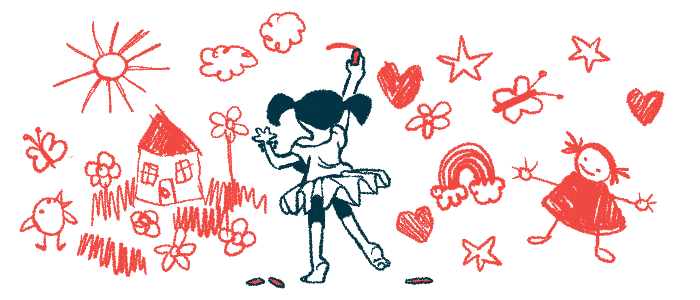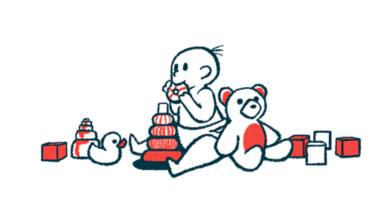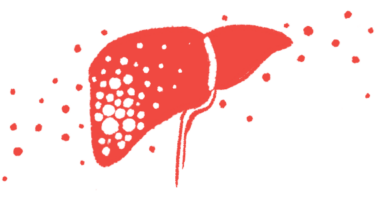Zolgensma may safely benefit older, heavier children with SMA: Study
New findings add to scarce data on therapy's use in patients 2 or older

The gene therapy Zolgensma (onasemnogene abeparvovec) did not cause any serious long-term safety problems when used in children with type 1 spinal muscular atrophy (SMA) in a real-world study from the U.K., and most treated patients experienced improvements in motor function.
“This is one of the largest studies of patients with SMA type 1 treated with [Zolgensma]. Our data indicate that in our treated cohort [Zolgensma] was a safe treatment resulting in improved motor function in the majority,” the researchers wrote.
The analysis showed that heavier or older patients were more likely to experience liver damage or inflammation requiring more intense treatment with steroids, but still some experienced notable functional improvements following gene therapy treatment.
The findings are particularly noteworthy since the study included children who were treated when they were older than 2 and/or heavier than 13.5 kg (nearly 30 pounds). Zolgensma is only approved in Europe to treat SMA patients weighing up to 21 kg (about 46 pounds), and in the U.S. it’s only authorized for children younger than age 2.
“The dataset expands the scarce safety data available for patients over 2 years old or weighing at least 13.5 kg, in particular demonstrating that there is a linear correlation of weight with hepatotoxicity [liver damage],” the scientists wrote, adding that these findings “emphasize the importance of careful pretreatment counselling and post-treatment monitoring, and of a careful and personalized risk-benefit analysis as some in this group may show significant motor improvement with treatment.”
The study, “Efficacy and safety of onasemnogene abeparvovec in children with spinal muscular atrophy type 1: real-world evidence from 6 infusion centres in the United Kingdom,” was published in The Lancet Regional Health – Europe. The work was funded by Novartis, the company that markets Zolgensma.
28 children age 2 or older or over 29 pounds involved in study
Zolgensma is a one-time gene therapy designed to deliver to the body’s cells a working version of the SMN gene whose defect causes SMA.
In this study, scientists reviewed data from 99 children with type 1 SMA who received Zolgensma treatment at centers in the U.K. Most of the children were treated in the first year of life and weighed less than 8.5 kg (about 18 lbs), though 21 of the children were ages 2 or older and seven children weighed more than 13.5 kg at the time of treatment. About half of the children had been on other SMA treatments prior to getting Zolgensma.
Data indicated that, for the vast majority of patients, treatment with Zolgensma led to improvements in motor function. Of 78 evaluable patients, 66 (84.6%) experienced an increase in scores on a motor function test called the CHOP-INTEND in the months and years following gene therapy.
Available data for other measures of motor function also indicated improvements following Zolgensma, and gains were seen regardless of whether or not patients had previously gotten other SMA treatments. This notably contrasts the typical course of SMA type 1 without treatment, where motor function worsens over time.
“In this study, over 80% of patients showed an increase in CHOP-INTEND score after [Zolgensma], indicating improvements in motor function,” the researchers wrote.
The team noted that motor function improvements were generally most dramatic in younger patients, but still they said that “a small number of patients aged 24 months or older did make significant gains.”
Liver injury a known safety risk with Zolgensma use
One of the biggest known safety concerns with Zolgensma is that the therapy commonly causes liver damage due to inflammation in the liver. Patients typically receive a course of anti-inflammatory steroid medications when Zolgensma is administered.
Safety data showed that most (87.9%) children treated with Zolgensma had elevated levels of liver damage markers. In 35 patients, steroid doses were doubled to help manage liver damage, which was usually effective for bringing these markers back down.
In statistical analyses, the researchers found that heavier patients were significantly more likely to have substantial liver damage and/or need a doubled dose of steroids. Compared with infants weighing less than 8.5 kg, children weighing more than 13.5 kg were at more than 20 times higher risk of liver damage or needing doubled steroids.
There also was a significant correlation between age and duration of steroid treatment: Each one-year increase in age was linked to a 13.8% increase in time spent taking steroids.
Given that the Zolgensma dose is proportional to body weight, older and heavier children require higher doses, which the scientists noted likely explains these findings.
Still, these data show a need for close monitoring by clinicians of steroid treatment in these patients.
“While [such treatment] is necessary for gene therapy administration, careful consideration and monitoring are needed to balance the benefits with the known side-effects of prolonged steroid use; steroid-sparing agents may be considered in certain cases,” the researchers wrote.
Nearly three-quarters of the children (71.7%) also had low platelet counts, or thrombocytopenia, in the first week following the administration of Zolgensma. About one-third (34%) had elevated levels of a marker of heart damage called troponin-1, but these lab abnormalities generally weren’t associated with notable symptoms and resolved with time. There weren’t notable associations between these complications and patients’ weight or age.
Two of the children died over the course of follow-up, one from complications of SMA and one from unrelated medical issues. Neither death was connected with Zolgensma treatment.









